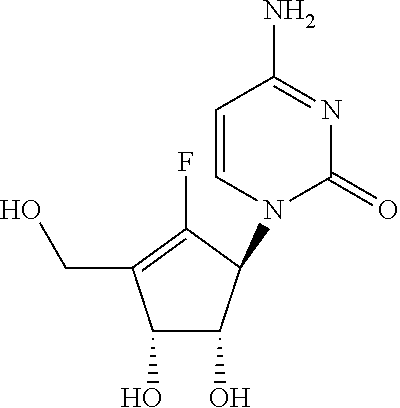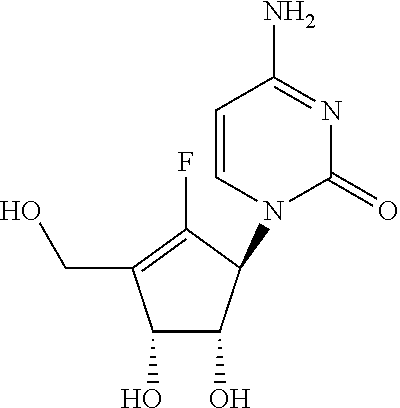Process for the preparation of 4-amino-1-((1S,4R,5S)-2-fluoro-4,5-dihydroxy-3-hydroxymethyl-cyclopent-2-enyl)-1H-pyrimidin-2-one
- Summary
- Abstract
- Description
- Claims
- Application Information
AI Technical Summary
Benefits of technology
Problems solved by technology
Method used
Image
Examples
example 1
Example 1a
(3aR,6aR)-6-(hydroxymethyl)-2,2-dimethyltetrahydrofuro[3,4-d][1,3]dioxol-4-ol (1)
[0044]
[0045]Into a 2000 L reactor was charged acetone (1200 L) and 2,2-dimethoxypropane (125 kg, 1200 mol, 1.2 eq), followed by D-ribose (150 kg, 999 mol). The mixture was stirred at ambient temperature. p-TSA (p-toluene sulfonic acid) (9.6 kg, 49.5 mol, 0.05 eq) was added in portions over 40 minutes. The reaction mixture was heated at 30° C. and monitored by TLC every hour. After 14 hours, TLC indicated complete conversion. A sample from the reaction mixture and standard samples for ribose and ribose acetonide were applied to a commercial silica gel TLC plate, and the plate was run in the mobile phase dichloromethane / ethanol=8:1. The plate was then sprayed with 10% H2SO4 in ethanol and heated using a heat gun. Ribose-related compounds gave dark spots on the plate. The Rf for Ribose was ˜0.1, while Rf for ribose acetonide (1) was usually 0.3˜0.35. To the reaction mixture was added triethylamin...
example 1b
[0046]To the 1000 L reactor 1 was charged 312 kg acetone and 40.0 kg D-Ribose, and the reaction mixture was cooled to 5-10° C. 1.60 kg of concentrated H2SO4 was added drop wise at 5-10° C. and the mixture was stirred at 5-10° C. for 1 hour after which time the mixture was allowed to warm to 25-30° C. and stirred for an additional 2 hrs. HPLC (ELSD) showed that 3.5% of D-ribose remained. The reaction mixture was cooled to 2CO3, 20 kg Na2SO4 in 1000 L reactor 2 and the mixture was stirred at 5±5° C. for 1 h to result in neutralization (pH>7). The mixture was filtered to remove Na2SO4, extra Na2CO3 and salt, and the cake was washed with acetone (10 kg×3). The combined acetone solution (504 kg, of which 702 g sampled was concentrated to 74.2 g residue to estimate 53.3 kg of total crude 1) was concentrated under vacuum at <20° C. followed by addition of 120 kg DCM (dichloromethane) and removal of the solvent at 20-25° C. under vacuum to furnish crude 1 (KF, 0.4%) to which 692 kg DCM were...
example 2a
(3aR,6aR)-2,2-dimethyl-6-((trityloxy)methyl)tetrahydrofuro[3,4-d][1,3]dioxol-4-ol (2)
[0047]
[0048]To the residue from the last step (Example 1a) (=189 kg, 999 mol) in the 2000 L (Example 1a) reactor was charged 900 L of DMF (dimethylformamide), and the solution was stirred 0.5 hour at ambient temperature. To the stirred solution was added trityl chloride (Trt-Cl, 336 kg, 1200 mol, 1.2 eq), triethylamine (202 kg, 1998 mol, 2 eq) and DMAP (dimethylaminopyridine) (7.3 kg, 60 mol, 0.06 eq). The mixture was stirred 32 hours at 30° C. TLC showed complete conversion (sample from the reaction mixture and standard samples for compounds 1 and 2 were applied to a commercial silica gel TLC plate, and the plate was run in the mobile phase petroleum ether / ethyl acetate=4:1. Compound 2, trityl chloride, trityl alcohol and trityl methyl ether can be detected under UV254. They can also be visualized using iodine treatment. The Rf for trityl methyl ether was ˜0.9. The Rf for compound 2 was ˜0.4. The R...
PUM
| Property | Measurement | Unit |
|---|---|---|
| temperatures | aaaaa | aaaaa |
| temperatures | aaaaa | aaaaa |
| temperatures | aaaaa | aaaaa |
Abstract
Description
Claims
Application Information
 Login to View More
Login to View More - R&D
- Intellectual Property
- Life Sciences
- Materials
- Tech Scout
- Unparalleled Data Quality
- Higher Quality Content
- 60% Fewer Hallucinations
Browse by: Latest US Patents, China's latest patents, Technical Efficacy Thesaurus, Application Domain, Technology Topic, Popular Technical Reports.
© 2025 PatSnap. All rights reserved.Legal|Privacy policy|Modern Slavery Act Transparency Statement|Sitemap|About US| Contact US: help@patsnap.com



